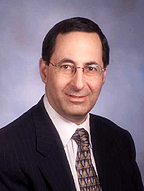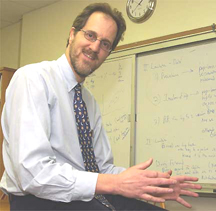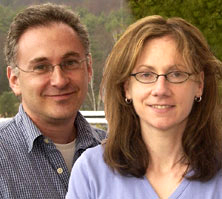
| T H E N I H C A T A L Y S T | M A Y – J U N E 2007 |
|
|
|
How to Get the Real StoryNIH HOLDS BOOT CAMP FOR HEALTH REPORTERS |
|
 |
|
Barry
Kramer, OMAR director and course host
|
Huh?
In an effort to generate consistently accurate scientific news coverage in the mass media, NIH for the past six years has been hosting an annual boot camp for print and television health journalists.
This three-day tutorial, held this year April 12–14, is aimed at arming reporters with the tools to understand and convey accurately the meaning of health-research findings; it’s also designed to alert them to potential sources of distortion.
The workshop—"Medicine in the Media: The Challenge of Reporting on Medical Research"—is sponsored by the NIH Office of Medical Applications of Research (OMAR) and the NIH Office of Communications, in partnership with the VA Outcomes Group (White River Junction, Vermont, Department of Veterans Affairs) and the Center for the Evaluative Clinical Sciences of Dartmouth Medical School, Hanover, N.H.
"Oversimplification of scientific data has proved troubling in some press accounts," said Barry Kramer, OMAR director and host of the gathering. "But I have seen clear changes for the better among graduates of our program," for instance, he said, regarding the issue of cancer screening.
"Our graduates no longer confuse longer survival postdiagnosis with decreased mortality," Kramer said.
"They’ve also captured the concept of overdiagnosis of non–life-threatening conditions that can result in serious side effects from unneeded interventions.
"Our graduates have incorporated ways to judge study design and to emphasize in their reporting when results of a trial are considered preliminary. And they have learned the importance of reporting absolute rates to judge the impact of an intervention" on disease incidence.
The Class of 2007
|
Just
the fact . . . that only 50 percent of media-hyped health items eventually
appear in scientific journals within five years surprised most attendees.
|
The 50 attendees at this year’s workshop, chosen from 275 applicants, varied in the size of their audience and in their medical-science training. Among them were a Lincoln, Neb., newspaper reporter, a newly hired Wall Street Journal reporter, an established ABC News World News producer, and a medically trained writer for a German health magazine.
Some had been assigned the health beat armed only with their journalism training and perhaps a few long-forgotten biology classes.
Just the fact, noted by several of the physician-researchers who served as faculty, that only 50 percent of media-hyped health items eventually appear in scientific journals within five years surprised most attendees.
Kramer listed some of the general impediments to a reporter’s success in telling an accurate story: "lack of formal scientific training, editorial pressures, text space availability, staffing cutbacks, and an overall interpretation bias that is inevitable in this field."
He noted that hot-button political issues, sensational anecdotes, and celebrity involvement often trump actual scientific data in the competition for media coverage of health and biomedical science.
Generally, NIH websites and public information offices can be relied upon for objective information. And researchers themselves can be contacted directly for results and data clarification, he said.
 |
 |
|
Going
by the Numbers:
(left to righ) Gil Welch, Steven Woloshin, and Lisa Schwartz, physician-researchers,
Dartmouth Medical School and VA Outcomes Group
|
|
The VA Outcomes–Dartmouth cohort—Gil Welch, Steven Woloshin, and Lisa Schwartz—led most of the nuts-and-bolts sessions that delved into the intricacies of study design and outcomes, selection bias, P values, the meaning of numbers, and how to assess the quality of data and their relevance to their reading and viewing audiences.
Basics: Know the Numbers, Look Before You Leap
In each module, research findings were tackled with analytic tools to clarify the nuances of relative risk, absolute risk, or just plain inevitable events in human existence.
Topics for lively interactive discussions included hope vs. hype in reporting on "breakthroughs" and "cures," distinguishing between randomized controlled trials and observational studies and anecdotes, and the need for reporters to identify and avoid expert sources of health information who may have either intellectual or financial conflicts of interest.
Reporters were told to exercise caution and skepticism in gathering information for stories on screening for disease or on the widespread incidence of a previously unrecognized condition (to thwart potential "disease mongering").
They were advised to question whether findings are verifiable, corroborated by previous findings, biologically plausible, or, where appropriate, exhibit a dose-response effect..
"Report the numbers; use charts" were frequent suggestions. Absolute rates, especially, were cited as the most helpful in painting an accurate picture of a drug’s effect on a condition. And no story would be complete without asking about and reporting on potential harmful side effects from any given intervention.
Presenting data on preliminary scientific findings (from uncontrolled trials, trials involving just a few people, or from animal studies), especially, requires painstaking accuracy and cautionary qualifiers, Woloshin and Welch emphasized in closing remarks.
All the attendees questioned (in an unscientific poll) agreed that the seminar would influence their future reporting efforts.
One television
news producer sighed while exiting the final lecture, acknowledging to a colleague
that she’d definitely have to keep her huge seminar binder around for future
reference. ![]()
| NOT FOR REPORTERS ONLY |
|
Physicians, too, sometimes overinterpret evidence from nonrandomized, observational studies, OMAR Director Barry Kramer observed a few weeks after the media tutorial. He pointed, as an example, to the long-held assumption proved false by the results of the Women’s Health Initiative that postmenopausal hormone-replacement therapy is cardioprotective. A
tutorial for health
professionals, organized by Kramer at the request of NIH Director
Elias Zerhouni,
was held at NIH a few years ago. It was called "Moving from Observational
Evidence to Clinical Trials: Why Do We Sometimes Get It Wrong?" |